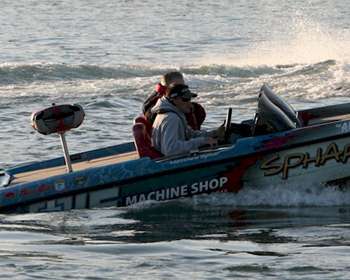
While the drift sock doesn't see very much action on the professional bass circuits, you can expect New York pro Matt Sphar to give it a workout whenever the Bassmaster Elite Series visits the vast Northern waters around his home state. "If I'm using a drift sock I'm fishing deep water and trying to drag my bait on the bottom," explains the pro. "The main reason I'll throw the drift sock out is to slow my drift and keep bottom contact with my tube or drop shot without having to use a really heavy weight on the lure."
So why doesn't he just use his trolling motor to control the boat? Sphar explains that when drifting over open water for smallmouth, a constant speed is critical to consistent success. "When I'm controlling the boat with just the trolling motor, I can slow down, but it's really inconsistent and the bait will change speed on the bottom."
When dragging a tube, bottom contact is critical, and a slow and steady drift is often the most productive approach to ensure the bait remains in the strike zone. "If you have a consistently slow drag, you flat out get more bites," he says.
While a drift sock may not be practical or applicable for bass anglers who fish small or shallow bodies of water, it is an important tool for anglers who fish big bodies of water in Northern states. "If there's a direct 15-mile-per-hour wind coming off of Lake Ontario or Erie, that's going to generate solid 2- to 3-foot waves," explains Sphar. "The drift sock allows me to use a lighter weight. Instead of having to use a 1/2-ounce weight, I can use a 3/8-ounce weight and still feel the bottom."
Sphar positions the sock on the side of the boat so that his boat rolls over the waves, rather than noisily crashing into them bow-first. Even though the wind is his primary means of movement, he adjusts the drift by using his trolling motor. Drifting this way is most effective when fishing for scattered smallmouth over a wide area. If he has located bass on a long reef, some drifts can last for hundreds of yards. Not only does the long drift allow Sphar to present his bait to more bass, but it also reduces the chance of spooking them with the trolling motor.
"Even when it's windy, the trolling motor will spook bass that are 20 feet deep," he claims, pointing out that the depth is equivalent to the length of his boat. "If you think about it that way, it's really not that far down to the bass." When he is fishing an isolated rockpile, Sphar will attempt to hold his boat near the productive area with only his trolling motor. It all comes down to time management. "On isolated spots where the bass will be concentrated, there's only a small window of opportunity to get bit. With a drift sock, I have to spend the time to haul it in, run back to the spot, and do it all over again," he says.
While the drift sock is used by Elite Series pros for precision drifts over specific structure, the weekend angler can also benefit by learning how to use one. "There are a lot of recreational anglers who always drift when they go fishing," he explains. "With a little practice, a drift sock will help those anglers keep their bait on the bottom and catch more bass."




